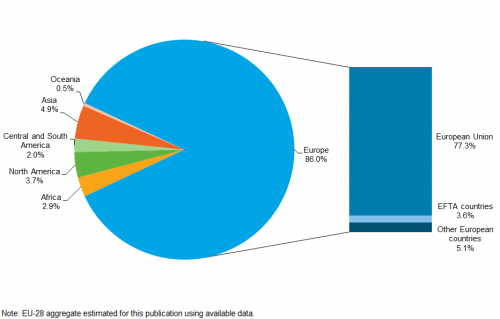Tourism statistics - EU and China
Data extracted in February 2018
No planned article update
Highlights
China was the 8th most popular non-EU destination for EU residents in 2016.
Over the last 10 years, the number of nights spent in the EU by tourists from China more than tripled, reaching nearly 25 million nights in 2016.
Nights spent by Chinese tourists of the total nights spent by guests from outside the EU, 2016 (%)
On 12 July 2016 the President of the European Commission, Jean-Claude Juncker, and the Chinese Prime Minister, Li Keqiang, announced that 2018 will be the EU-China Tourism Year (ECTY). This initiative provides ‘a unique opportunity to increase visitors’ flows and investments on both sides’ (Elżbieta Bieńkowska, European Commissioner responsible for tourism — ‘European Tourism Forum’ in Bratislava on 11 October 2016).
This article takes a look at tourism flows between the European Union (EU) and China. The first section focuses on visits to Asia, and in particular China, made by EU residents. The second looks at visits made by Chinese residents to the EU using accommodation statistics (nights spent in rented tourist accommodation).
Full article
Asia is the second most visited destination outside Europe for EU residents
Europe — and very often a tourist’s own country of residence — remained the most attractive destination for most trips made by Europeans. It accounted for 86.0 % of the total number of trips made in 2016 (see Figure 1). The top continent visited outside Europe was America with 5.7 % of total trips, followed by Asia with 4.9 %.
Figure 2 takes a closer look at trips made outside the EU. Trips to other destinations in Europe — such as Turkey, Switzerland, Norway, Russia and all other non-EU European countries — made up the largest share (38 %). Nonetheless Asia accounted for more than one in five trips outside the EU (22 %). When measured in terms of nights spent and expenditure, Asia’s share of all non-EU tourism increases to 29 % and 28 % respectively. EU residents made 15.2 million trips to Asia — representing a total of 263.5 million nights — and spent EUR 25.5 billion on those trips. A part of the EUR 25.5 billion spent stayed within the EU economy, for instance for intercontinental flights operated by European airlines or commission fees charged by European travel agencies.
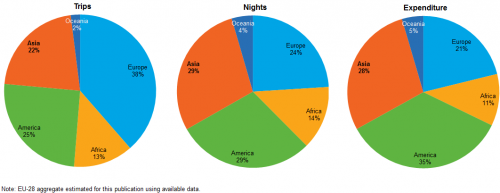
Source: Eurostat (tour_dem_ttw), (tour_dem_tnw), (tour_dem_extotw)
China is the 8th most popular non-EU destination for EU residents
China is becoming a popular travel destination for Europeans. In 2016, China ranked number 8 among non-EU destinations (see Figure 3 and Table 1). The United States was the most popular non-EU destination, followed by countries neighbouring the EU (Turkey, Switzerland, Norway and Russia).
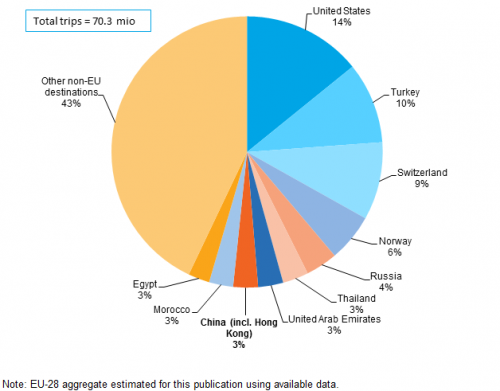
Source: Eurostat (tour_dem_ttw)

Source: Eurostat (tour_dem_ttw), (tour_dem_tnw), (tour_dem_extotw)
Two Asian countries — Thailand and the United Arab Emirates (each of them representing just above 3.0% of EU residents' trips to non-EU destinations) — were still slightly ahead of China (3.0 %) in 2016. EU residents made 2.1 million trips to China in 2016, and stayed on average 15.6 nights. Total spending on trips with China as main destination was EUR 5.1 billion (China climbed to third place in expenditure terms — see Table 1).
In the five year period 2012—2016, the number of trips by EU residents to China increased by 16 % (data based on 20 countries, which account for 76 % of the trips made by EU residents).
Tourism from China to the EU has tripled in ten years
The number of nights spent in the EU by tourists from China has more than tripled over the last ten years, reaching nearly 25 million nights in 2016. Tourism from China has risen more than that from other major non-EU countries such as the United States, Russia or Brazil (see Figure 4).

Source: Eurostat (tour_occ_ninraw)
Figure 5 shows that the overwhelming majority of foreigners staying in tourist accommodation establishments in EU countries came from other EU countries (72 %) or other European countries (9 %). Of non- European tourists, those from Asia accounted for the biggest share of nights spent (8 %).
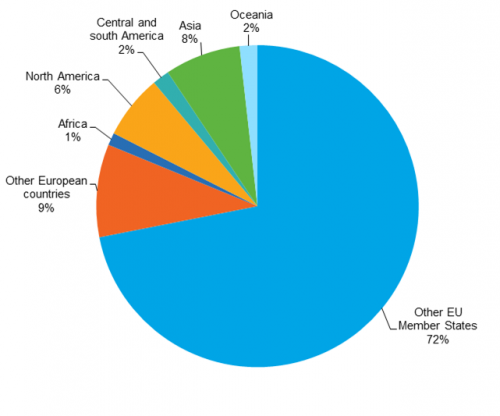
Source: Eurostat (tour_occ_ninraw)
1.7 % of all nights spent in EU-28 countries by non-residents was by tourists from China; for Finland the share was nearly 5 % (see Figure 6).
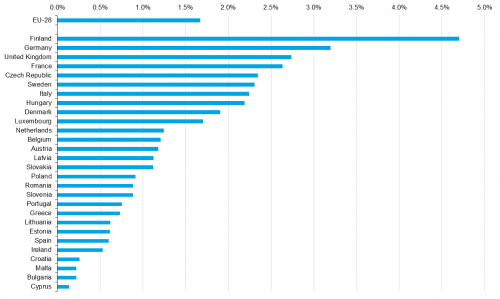
Source: Eurostat (tour_occ_ninraw)
The share of Chinese tourists out of the total nights spent by tourists coming from outside the EU was almost 6 % (see Figure 7). Luxembourg was very popular among Chinese tourists; 1 in 8 nights spent by non-EU tourists in Luxembourg, was spent by a Chinese tourist.
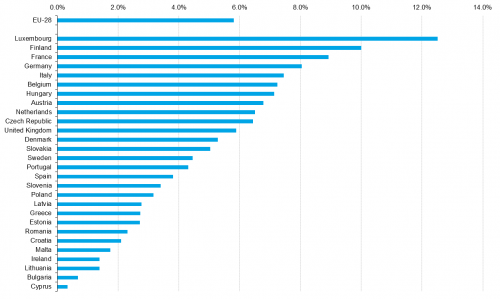
Source: Eurostat (tour_occ_ninraw)
Tourists from China mainly stayed in just four EU countries: more than 7 out of 10 overnight stays by tourists from China to the EU were in the United Kingdom (31 %), Italy (18 %), France (13 %) and Germany (10 %) (see Figure 8).
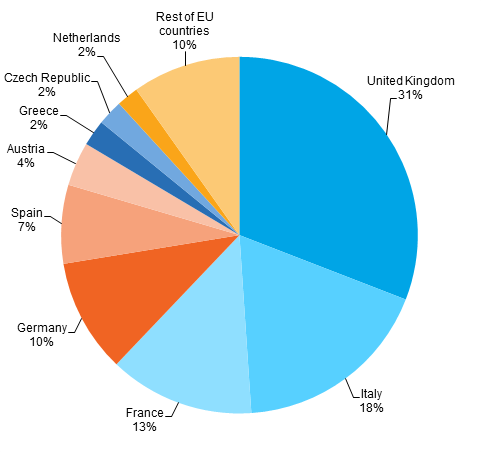
Source: Eurostat (tour_occ_ninraw)
The EU is a net exporter of travel services to China
In 2016, the EU exported travel services valued at nearly EUR 7 billion [1]. In the same year, the EU imported nearly EUR 3 billion from China (i.e. Europeans’ spending on trips in China). Europe was a net exporter of travel services with a positive balance of EUR 4 billion.
Until 2008 (see Figure 9) the travel item showed a negative balance in the EU’s balance of payments with China, with debits exceeding credits.

Source: Eurostat (bop_eu6_q)
The growth rates of the monetary flows (credits and debits) were in line with the underlying physical flows of Chinese tourists staying in European accommodation and EU tourists making trips to China respectively (see above).
Source data for tables and graphs
Data sources
This article is an analysis of harmonised data collected by the Member States in the frame of the Regulation (EU) No 692/2011 of the European Parliament and of the Council concerning European statistics on tourism.
Tourism, in a statistical context, refers to the activity of visitors taking a trip to a destination outside their usual environment, for less than a year. It can be for any main purpose, including business, leisure or other personal reasons other than to be employed by a resident person, household or enterprise in the place visited.
Tourism statistics in the EU consist of two main components: on the one hand, statistics relating to capacity and occupancy of collective tourist accommodation; on the other, statistics relating to tourism demand. In most EU Member States, the former are collected via surveys filled in by accommodation establishments, while the latter are mainly collected via traveller surveys at border crossings or through household surveys.
Context
EU-China Tourism Year (ECTY) was launched in Venice on 19 January 2018. This initiative, agreed at the 2017 EU China Summit, aims at supporting the development of new and better travel itineraries, promoting inter-cultural understanding, and enhancing travel and tourism experiences, including greater promotion and more sustainable tourism.
According to a United Nations World Tourism Organisation (UNWTO) publication titled ‘Tourism highlights’, the EU is a major tourist destination, with five of its Member States among the world’s top 10 destinations in 2016. According to this publication, China continues to consolidate its position as the world’s largest travel market in terms of both outbound travel and expenditure.
Tourism has the potential to contribute towards employment and economic growth, as well as to development in rural, peripheral or less-developed areas. These characteristics drive the demand for reliable and harmonised statistics within this field, as well as within the wider context of regional policy and sustainable development policy areas.
Tourism can play a significant role in the development of European regions. Infrastructure created for tourism purposes contributes to local development, while jobs that are created or maintained can help counteract industrial or rural decline. Sustainable tourism involves the preservation and enhancement of cultural and natural heritage, ranging from the arts to local gastronomy or the preservation of biodiversity.
Direct access to
- Tourism (t_tour)
- Annual data on trips of EU residents (ESMS metadata file — tour_dem_esms)
- Capacity and occupancy of tourist accommodation establishments (ESMS metadata file — tour_occ_esms)
- Methodological manual for tourism statistics
- Projects and studies, see Methodology for tourism statistics and Tourism Satellite Accounts (TSA)
- Regulation (EU) No 692/2011 of 6 July 2011 concerning European statistics on tourism and repealing Council Directive 95/57/EC.
- Summaries of EU Legislation: Tourism statistics
- Regulation (EU) No 1051/2011 of 20 October 2011 implementing Regulation (EU) No 692/2011 concerning European statistics on tourism, as regards the structure of the quality reports and the transmission of the data.
- Regional Statistics Illustrated - select statistical domain 'Tourism' (top right)
- EC-ETC Tourism flows from China to the European Union: Preparatory report for the 2018 EU China Tourism Year(ETC, 2017)
- Agenda for a sustainable and competitive European tourism (Communication from the European Commission, October 2007)
- European Commission - Directorate-General for Internal Market, Industry, Entrepreneurship and SMEs - Tourism
Notes
- ↑ Data from the Balance of Payments.
